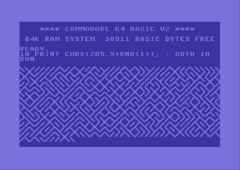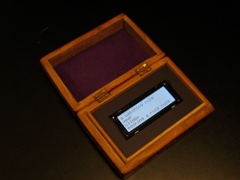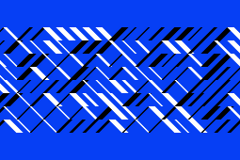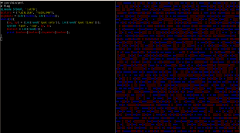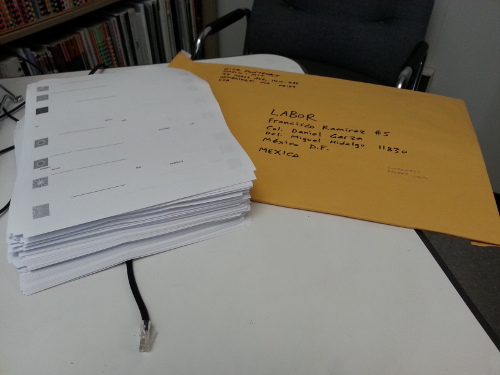I like clicking through this: “Psychographics: Consumer Survey” by Dane Watkins. And I learned something about myself by doing so. I think. Yes.
“Programs at an Exhibition” March 6-16
Nick Montfort & Páll Thayer
Programs at an Exhibition
At the Boston Cyberarts Gallery
141 Green Street, Jamaica Plain, MA 02130
Located in the Green Street T Station on the Orange Line
Phone number: 617-522-6710
The exhibit runs March 6 through March 16.
Opening: 6pm-9pm, Thursday March 6.

Part of the life of remarkable artworks is that they are appropriated, transformed, and made new. In Programs at an Exhibition, two artists who use code and computation as their medium continue the sort of work others have done by representing visual art as music, by recreating performance pieces in Second Life, and by painting a mustache and goatee on a reproduction of the Mona Lisa. Programs at an Exhibition presents computer programs, written in Perl and Commodore 64 BASIC, each running on its own dedicated computer. The 20th century artworks reenvisioned in these programs include some by painters and visual artists, but also include performances by Joseph Beuys and Vito Acconci. All of the underlying code is made available for gallery visitors to read; they are even welcome to take it home, type it in, and run or rework these programs themselves.
The programs (Commodore 64 BASIC by Nick Montfort, Perl by Páll Thayer) re-create aspects of the concepts and artistic processes that underlie well-known artworks, not just the visual appearance of those works. They participate in popular and “recreational” programming traditions of the sort that people have read about in magazines of the 1970s and 1980s, including Creative Computing. Programmers working in these traditions share code, and they also share an admiration for beautiful output. By celebrating such practices, the exhibit relates to the history of art as well as to the ideals of free software and to the productions of the demoscene. By encouraging gallery visitors to explore programming in the context of contemporary art and the work of specific artists, the exhibit offers a way to make connections between well-known art history and the vibrant, but less widely-known, creative programming practices that have been taken up in recent decades by popular computer users, professional programmers, and artists.
The Perl programs in the exhibit are from Microcodes, a series of very small code-based artworks that Páll Thayer began in 2009. Each one is a fully contained work of art. The conceptual meaning of each piece is revealed through the combination of the title, the code and the results of running them on a computer. Many contemporary programmers view Perl as a “dated” language that saw its heyday in the early ages of the World Wide Web as the primary language used to combine websites with databases. Perl was originally developed by Larry Wall, whose primary interest was to develop a language for parsing text. Because of his background in linguistics, he also wanted the language to have a certain degree of flexibility which has contributed to its motto, “There’s more than one way to do it.” “That motto, ‘TMTOWTDI,’ makes Perl challenging for professional programers who have to take over other’s people code and may struggle to make sense of it,” Thayer said. “But it’s one of the main reasons that Perl, a very expressive programming language, appealed to me in developing this project. This flexibility encouraged Perl programmers to explore individual creative expression in the writing of functional code.”
“Páll’s work in Microcodes engages explicitly with the way computer programs are read by people and hwo they have meanings to those trying to understand them, modify them, debug them, and develop them further,” Nick Montfort said. “The Perl programs in Microcodes are quite readerly when compared to my BASIC programs. I’ve tried to engage with a related, but different documented historical tradition — the one-line BASIC program — as it works in a particular computer, the Commodore 64, and to dive into what that particular computer can do using a very limited amount of code, given these many formal, material, and historical specifics. Because my programs are harder to understand, even though they are written in a more populist programming language, I’m including versions of the program that I have rewritten in a clearer form and that include comments.” Montfort’s related projects include a collaborative book, written with nine others in a single voice, that focuses on a particular Commodore 64 BASIC one-liner. The book, published in 2012, is named after the program that is its focus, 10 PRINT CHR$(205.5+RND(1)); : GOTO 10. Montfort also writes short programs to generate poetry. These include two collections of Perl programs that are constrained in size: his ppg256 series of 256-character programs, and a set of 32-character concrete poetry generators, Concrete Perl. His book #! (pronounced “Shebang”) collects these and other poetry generators, along with their output, and is forthcoming from Counterpath Press.
Nick Montfort develops literary generators and other computational art and poetry, and has participated in dozens of collaborations. He is associate professor of digital media at MIT and faculty advisor for the Electronic Literature Organization, whose Electronic Literature Collection Volume 1 he co-edited. Montfort wrote the book of poems Riddle & Bind and co-wrote 2002: A Palindrome Story with William Gillespie. The MIT Press has published four of Montfort’s collaborative and individually-authored books: The New Media Reader (co-edited with Noah Wardrip-Fruin), Twisty Little Passages, Racing the Beam (co-authored with Ian Bogost), and most recently 10 PRINT CHR$(205.5+RND(1)); : GOTO 10, a collaboration with Patsy Baudoin, John Bell, Ian Bogost, Jeremy Douglass, Mark C. Marino, Michael Mateas, Casey Reas, Mark Sample, and Noah Vawter that Montfort organized. Nick Montfort’s site, with his digital poems and a link to a free PDF of 10 PRINT: http://nickm.com
Páll Thayer is an Icelandic/American artist working primarily with computers and the Internet. He is a devout follower of open-source culture. His work is developed using open-source tools and source code for his projects is released under a GPL license. His work has been exhibited at galleries and festivals around the world with solo shows in Iceland, Sweden, and New York and notable group shows in the US, Canada, Finland, Germany, and Brazil. Páll Thayer has an MFA degree in visual arts from Concordia University in Montréal. He is an active member of Lorna, Iceland’s only organization devoted to electronic arts. He is also an alumni member of The Institute for Everyday Life, Concordia/Hexagram, Montréal. Páll Thayer currently works as a lecturer and technical support specialist at SUNY Purchase College, New York. Páll Thayer’s Microcodes site: http://pallthayer.dyndns.org/microcodes/
Ten programs will be exhibited, running on ten computers. Two of them, one in Perl by Páll Thayer and one in Commodore 64 BASIC by Nick Montfort, are based on the same artwork, Jasper Johns’s Flag:

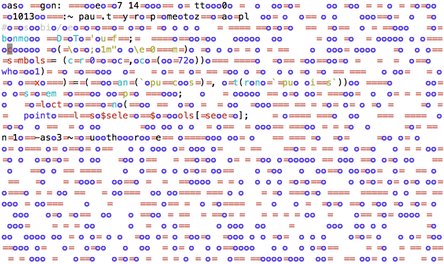
Flag · Páll Thayer
Perl program · 2009
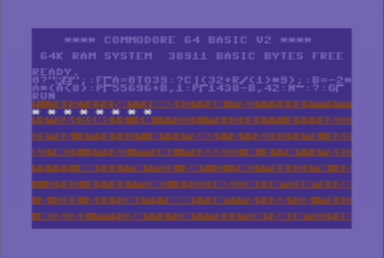
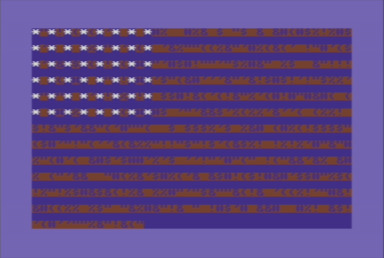
After Jasper Johns · Nick Montfort
one-line Commodore 64 BASIC program · 2013
“Programs at an Exhibition” Opens March 6
I’ll post more on this soon, but for now, let me invite you to the opening of my & Páll Thayer’s show at the Boston Cyberarts Gallery: 141 Green Street, Jamaica Plain, MA 02130, located in the Green Street T Station on the Orange Line, 617-522-6710.
The opening is 6pm-9pm on Thursday March 6.
The exhibit (which will be up March 6-16) will feature ten programs (five in Commodore 64 BASIC by Nick Montfort, five in Perl by Páll Thayer), each running on its own computer. The programs re-create aspects of the concepts and artistic processes that underlie well-known artworks, not just the visual appearance of those works. They participate in popular and “recreational” programming traditions of the sort that people read about in magazines of the 1970s and 1980s, including _Creative Computing._ Programmers working in these traditions share code, and they also share an admiration for beautiful output. By celebrating such practices, the exhibit relates to the history of art as well as to the ideals of free software and to the productions of the demoscene. By encouraging gallery visitors to explore programming in the context of contemporary art and the work of specific artists, the exhibit offers a way to make connections between well-known art history and the vibrant, but less widely-known, creative programming practices that have been taken up in recent decades by popular computer users, professional programmers, and artists.


Flag · Páll Thayer
Perl program · 2009


After Jasper Johns · Nick Montfort
one-line Commodore 64 BASIC program · 2013
Purple Blurb’s Digital Writing Events this Semester
Purple Blurb, MIT’s digital writing series organized by Prof. Nick Montfort of the Trope Tank, powers on, thanks to the four excellent writers/artists who will be presenting in Spring 2014. All events this semester will be held Mondays at 5:30pm in MIT’s room 14E-310.
March 10, 5:30pm in 14E-310:
Páll Thayer
Microcodes
Short Perl programs that are also artworks, presented for viewers to read, download, and execute. Thayer will trace some key steps showing how he went from his background in painting and drawing to presenting code as his artwork.
Páll Thayer is an Icelandic artist working primarily with computers and the Internet. He is devout follower of open-source culture. His work is developed using open-source tools and source-code for his projects is always released under a GPL license. His work has been exhibited at galleries and festivals around the world with solo shows in Iceland, Sweden and New York and notable group shows in the US, Canada, Finland, Germany and Brazil (to name but a few). Pall Thayer has an MFA degree in visual arts from Concordia University in Montreal. He is an active member of Lorna, Iceland’s only organization devoted to electronic arts. He is also an alumni member of The Institute for Everyday Life, Concordia/Hexagram, Montreal. Pall Thayer currently works as a lecturer and technical support specialist at SUNY Purchase College, New York.
April 7, 5:30pm in 14E-310:
Lance Olsen
Experimental writing & video
Including a reading from his recent book _[[ there. ]]_ and video from his _Theories of Forgetting_ project.
Lance Olsen is author of more than 20 books of and about innovative writing, including two appearing this spring: the novel based on Robert Smithson’s earthwork the _Spiral Jetty, Theories of Forgetting_ (accompanied by a short experimental film made by one of its characters), and _[[ there. ]],_ a trash-diary meditation on the confluence of travel, curiosity, and experimental writing practices. His short stories, essays, and reviews have appeared in hundreds of journals and anthologies. A Guggenheim, Berlin Prize, N.E.A. Fellowship, and Pushcart Prize recipient, as well as a Fulbright Scholar, he teaches experimental theory and practice at the University of Utah.
April 28, 5:30pm in 14E-310:
Scott Rettberg
Videos & combinatory videos
Produced in collaboration with Roderick Coover, Nick Montfort, and others, including: _The Last Volcano, Cats and Rats, Three Rails Live and Toxicity._
Scott Rettberg is Professor of Digital Culture in the department of Linguistic, Literary, and Aesthetic studies at the University of Bergen, Norway. Rettberg is the project leader of ELMCIP (Electronic Literature as a Model of Creativity and Innovation in Practice), a HERA-funded collaborative research project, and a founder of the Electronic Literature Organization. Rettberg is the author or coauthor of novel-length works of electronic literature, combinatory poetry, and films including _The Unknown, Kind of Blue, Implementation, Frequency, Three Rails Live, Toxicity_ and others. His creative work has been exhibited online and at art venues including the Chemical Heritage Foundation Museum, Palazzo dell Arti Napoli, Beall Center, the Slought Foundation, The Krannert Art Museum, and elsewhere.
May 5, 5:30pm in 14E-310:
Jill Walker Rettberg
Selfies
With examples from her own work as well as from photobooths, older self-portraits, and entries from others’ diaries, in her talk “Seeing Ourselves Through Technology: How We Use Selfies, Blogs and Wearable Devices to Understand Ourselves.”
Jill Walker Rettberg is Professor of Digital Culture at the University of Bergen in Norway. Her research centers on how we tell stories online, and she has published on electronic literature, digital art, blogging, games and selfies. She has written a research blog, jilltxt.net, since October 2000, and co-wrote the first academic paper on blogs in 2002. Her book _Blogging_ was published in a second edition in 2014. In 2008 she co-edited an anthology of scholarly articles on _World of Warcraft._ Jill is currently writing a book on technologically mediated self-representations, from blogs and selfies to automated diaries and visualisations of data from wearable devices.
No Code: Null Programs
Just posted: **TROPE-13-03 – No Code: Null Programs** by Nick Montfort, in the Trope Report series (technical reports from my lab the Trope Tank at MIT).
>To continue the productive discussion of uninscribed artworks in Craig Dworkin’s _No Medium,_ this report discusses, in detail, those computer programs that have no code, and are thus empty or null. Several specific examples that have been offered in different contexts (the demoscene, obfuscated coding, a programming challenge, etc.) are analyzed. The concept of a null program is discussed with reference to null strings and files. This limit case of computing shows that both technical and cultural means of analysis are important to a complete understanding of programs – even in the unusual case that they lack code.
Please share and enjoy. And do feel free to leave a comment here if anything to add on this topic, or if you have a question about this report. I’d be glad to continue the discussion of these unusual programs.
Ultraconcentrated and a Suit that Outdoes the Moon
I went to New York to attend the opening of Ultraconcentrated, Casey Reas’s solo show at bitforms. As a rather pure computationalist, one who always tries to maximize code and minimize data, I was a teensy bit wary of the data-driven nature of Casey’s work in this show, which is based, to some extent, on digital television. This idea of using data wasn’t completely offputting, though; Casey and collaborator Ben Fry have done a nice mural here at MIT, which I often walk by, called Signals and based on the interconnections of proteins.
The works in the show certainly didn’t display data in a straightforward or disappointing way. There were prints (Control Room (Forward Command Post)) that seemed studies of color. There were also two laser etched anodized aluminum pieces, each with two semicircular segments, which present television signals as if they were converted to a monochrome and very uncanny landscape or cityscape. The main screen that turned on — two screens, actually — was a diptych video that shifts very rarely into a somewhat figurative or identifiable image. The work (including that on the 6th floor) was all appealing and interesting. It certainly justified the packed house at the opening.
Overall, the trip was great, as we caught up with several friends in New York. The other art-related encounters were excellent, too. I met Ben Fino-Radin and others at the XFR STN exhibit and project at the New Museum, where video and born-digital materials were being recovered for artists.
Most oddly, as I was walking though Chelsea after seeing Casey’s show, I noticed an opening of collage art by someone who — however conventional, however absent from today’s avant-garde — has written a great amount of poetry that has pleased and provoked me over the years: Mark Strand. (Among other things, such as dozens of poetry books, he is the author of a very offbeat book of prose, Mr. and Mrs. Baby.) He was wearing a white suit, as I expected (see, for instance, the beginning of his book Dark Harbor). And while I couldn’t think of anything to say to him that would have merited interrupting the excellent time he seemed to be having talking with others, it was nice to see his collages and share the room with him for a bit.
Hoc Opus, Hic Labor Est
The Internent isn’t just the Web; it’s also telnet, Gopher, email … and the Worl. Here are 500 pages of the Worl that I printed out and mailed today to Kenneth Goldsmith’s exhibit, Printing Out the Internet.
The Worl is accessible to anyone who has a recent Web browser and has installed The Deletionist.
Just Posted, Computational, Conceptual
Now online: “The First M Numbers Classified in Alphabetical Order.”
This was my New Year’s poem for 2013. It is based on Claude Closky’s 1989 “Les 1000 premiers nombres classés par ordre alphabétique” [The First 1000 Numbers Classified in Alphabetical Order], which he laser printed and which begins this way:
A full image of the first page spread (which is the source for the image above), and more context for this work, is available on this page.
The printed copies of my “The First M…” were dot-matrix printed on two connected sheets of fanfold paper. In the printout, as online, I included the program as well as the output.
Chercher le Text Call for Artistic Works
Here is the call for artistic proposals for the ELO 2013 “Chercher le Text” in Paris!
The “chercher le texte” event deals with literary issues and text-oriented multimedia practices on digital devices: digital books, texts generated or animated through programming, fiction hypertexts, “manipulable”, playable works, or on the contrary works whose very program embraces literariness. The considered devices range from computers to mobile devices, including social networks. They can be used in various contexts: installations, performances, personal devices designed for digital reading. These contexts range from solo reading to collaborative or participative reading.
This event will represent an opportunity to showcase young artists and bring together two worlds, which otherwise barely come into contact with one another: that of the experimental digital literature forms deriving from the second half of the 20th century avant-garde movements and that of the digital writings, as used by authors coming from the book world and who have taken over the digital technologies, namely blogs and e-books.
In this context, the Musique et Informatique de Marseille (MIM) laboratory associates with team Écritures Numériques from Paris 8 Paragraphe laboratory, the digital literature European network Digital Digital Digital Littérature (DDDL), the Electronic Literature Organization (ELO), the Bibliothèque Publique d’Information (BPI), the Bibliothèque Nationale de France (BNF), the Cube, the Labex Art-H2H coordinated by Paris 8 and the École nationale supérieure des Arts Décoratifs (EnsAD) to organize the following events:
- An online virtual gallery on the DDDL network website.
- Four events consisting of performances and projections of works, from September 23 to 26, 2013, in the small room of the Centre Pompidou, the big auditorium of the Bibliothèque Nationale de France and the Cube amphitheater.
- A six-week exhibition on “digital literatures from the past and future” in the BNF lab room of the Bibliothèque Nationale de France, which will be launched on September 24, 2013. This exhibition will feature the virtual gallery and a selection of digital literary works with emphasis on the works designed for touch-pads and e-readers.
Artists, especially young ones, are invited to propose one or several work(s). Please send your proposals to work@chercherletexte.org before February 18.
This is a summary of the call – see www.chercherletexte.org for full details.
Radical Books of 2012 (6/7)
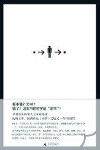
· →  → ·
→ ·
Book from the Ground
Xu Bing
120 pages
The dot of unconsciousness opens – and then winks out again. The book, one point in a project that Xu Bing has undertaken since 2003, is written entirely as a series of symbols, narrating a daily odyssey (or perhaps a Ulysses) that is read left-to-right and from top to bottom but almost entirely without the use of words or letters – they only appear as part of logos and the like. Symbols derived from Neurath’s Isotype system, which led to today’s airport signs, are used alongside emoticons and computer icons to describe the workplace experiences, fraternal beverage consumption, dating, and insomniac video game play of a rather harried, forgetful, busy, and not particularly productive generic man who lives in a city located on [globe icon]. By borrwing a bit from comic conventions within this typographical framework, not only actions but also thoughts and the topics of discussions are depcited (to me, at least) legibly.
Farking, Processing, and 10 PRINT
The book 10 PRINT CHR$(205.5+RND(1)); : GOTO 10 (and the program) have been discussed as “cool” on Fark. (I was hoping for a Photoshop contest with the program’s output, but this is nice, too…)
One of my co-authors, Casey Reas, has issued a 10 PRINT design challenge to the Processing community. There’s already been one program written in reply.
10 PRINT at the Boston Cyberarts Gallery
As seen on Bruce Sterling’s blog, we have an 10 PRINT (or, to be precise, a 10 PRINT CHR$(205.5+RND(1)); : GOTO 10) event tomorrow, Wednesday, here in Boston. The Boston Cyberarts Gallery (formerly AXIOM) is located in the Green Street T station on the Orange Line; the event’s at 7:30pm.
An evening to celebrate the publication by MIT Press of 10 PRINT CHR$(205.5+RND(1)); : GOTO 10. This book takes a single line of code-the extremely concise BASIC program for the Commodore 64 inscribed in the title-and uses it as a lens through which to consider the phenomenon of creative computing and the way computer programs exist in culture. The ten authors of this collaboratively written book, treat code not as merely functional but as a text-in the case of 10 PRINT, a text that appeared in many different printed sources-that yields a story about its making, its purpose, its assumptions, and more.
They consider randomness and regularity in computing and art, the maze in culture, the popular BASIC programming language, and the highly influential Commodore 64 computer.
Nick Montfort will start off the evening leading a discussion among co-authors and the audience about this celebrated piece of software. And there will be a short hackathon.
ATNE Salons are informal discussions on art/technology topics. At each event, we start the discussion with a presentation by an expert in the field who’ll provide context and raise provocative questions. Next, with the help of a moderator, we turn the debate over to you. Share your ideas, discover new ones and participate in analytical discourse and artistic cross-pollination.
About Art Technology New England
ATNE is a member-run organization whose purpose is to foster existing and new collaborations in the New England art and technology communities, including non-profit, academic & corporate entities, as well as individuals.
When: Wednesday, November 28th, 7:30pm
Where: Boston Cyberarts Gallery,
141 Green St.,
Jamaica Plain, MA 02130Free event!
RSVP to info [at] atne.org
www.atne.org
Statistics Outta My Face
Ben Grosser created Facebook Demetricator, a tool that removes counts from Facebook, so that instead of displaying “14,836 people like this” your interface will simply say “people like this.”
I love the concept. I haven’t seen it in action myself, because of my use of a manually-implemented “DeFacebookizer” that, rather than enmeshing me in the most direct possible corporate system of social control and structure, leaves me with only the heterogeneous, diverse, and open communications from people on the World Wide Web. The Web is not a pure wonderland, though. These sorts of communications are, of course, also continually subject to statistical analysis and displays of counts – how many comments on a blog post, for instance. To intervene in the count-obsession of digital media, it makes sense to go to where it is most prominent.
Grosser discusses his deaugmentation of Facebook in an interview with Matthew Fuller.
S=A=U=S=A=G=E
Alternate (actually, rejected) titles for the famous journal L=A=N=G=U=A=G=E, recently revealed in Jacket2.
I don’t know about you, but Charles Bernstein and Bruce Andrews’s cutting room floor is often better than what ends up stuffed into my projector.
For instance, I see that Rhizome, which wound up being used, is on the list.
Maybe the next interactive fiction journal could be called Inventory.
And, I think Salad is still a great title – maybe even a better one today. It’s a dish best served cold.
Be Kind, Reconstruct
It’s not bigger and longer than _Star Wars,_ but it is more uncut: “Death of the Author [Psycho Shower Scene RECON]” by Dick Whyte. This, somewhat like the later famous Star Wars video, is a “reconstruction of Alfred Hitchcock’s famous shower scene from Psycho using amateur YouTube remakes.” 57 of them.
If you got that and you’re ready to increase the avant-garde, see also “John Cage – 4’33” [May ’68 Comeback Special RECON]” and “Andy Warhols Eat A Hamburger [38 Scenes From YouTube RECON].” All from 2010, but recalled here for your enjoyment.
Big Reality
I went last weekend to visit the Big Reality exhibit at 319 Scholes in Bushwick, Brooklyn. It was an adventure and an excellent alternative to staying around in the East Village on March 17, the national day of drunkenness. The gallery space, set amid warehouses and with its somewhat alluring, somewhat foreboding basement area (I had to bring my own light source to the bathroom), was extremely appropriate for this show about tabletop and computer RPGs and their connections to “real life.” Kudos to Brian Droitcour for curating this unusual and incisive exhibit.
A few papers of mine are probably the least spectacular contribution to the show. There are three maps of interactive fiction games that I played in the 1980s and my first map of nTopia, drawn as I developed Book and Volume. The other work includes some excellent video and audio documentation of WoW actions and incidents; fascinatingly geeky video pieces; the RPGs Power Kill, Pupperland, and Steal Away Jordan; player-generated maps; a sort of CYOA in which you can choose to be a butcher for the mob or Richard Serra; and an assortment of work in other media. Plus, the performance piece “Lawful Evil,” in which people play a tabletop RPG in the center of the gallery, is running the whole time the show is open.
Which, by the way, is until March 29.
And, the catalog is excellent, too, with essays and other materials that bear on the question of how supposedly escapist role-playing tunnels into reality.
Codings
Codings shows the computer as an aesthetic, programmed device that computes on characters. The works in the show continue and divert the traditions of concrete poetry and short-form recreational programming; they eschew elaborate multimedia combinations and the use of network resources and instead operate on encoded letters, numbers, punctuation, and other symbols that are on the computer itself.
////////////////////////// Giselle Biguelman
///////////////////////// Commodore Business Machines, Inc.
//////////////////////// Adam Parrish
/////////////////////// Jörg Piringer
////////////////////// Casey Reas
///////////////////// Páll Thayer
Curated by Nick Montfort
Pace Digital Gallery
Feb 28th – March 30th, 2012 (with regular gallery hours Mon-Thu 12-5pm).
Panel with artists Adam Parrish and Páll Thayer and the curator, and opening reception, Feb 28th, 5-7pm.
The Codings catalog is available as a PDF for download (6MB).
The Pace Digital Gallery is directed by Frank T. Marchese and Jillian Mcdonald and is located at 163 William St, New York, NY. More information on the works exhibited, and directions to the gallery, can be found at the Pace Digital Gallery site.

